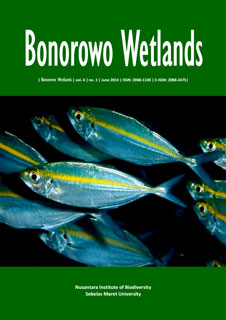Strategy for mangrove ecosystem rehabilitation throughout damaged level analysis at Muara Angke Wildlife Sanctuary, Jakarta
##plugins.themes.bootstrap3.article.main##
Abstract
Abstract. Mayalanda Y, Yulianda F, Setyobudiandi I. 2014. Strategy for mangrove ecosystem rehabilitation throughout damaged level analysis at Muara Angke Wildlife Sanctuary, Jakarta. Bonorowo Wetlands 4: 12-36. The phenomenon of mangrove degradation that occurred in the last decade at Muara Angke Sanctuary is caused by various factors, such as land conversion to ponds for aquaculture, pollution, sedimentation, and a variety of human activities around. Mos of the rehabilitation is conducted in this area, are to recover mangrove ecosystem. Unfortunately, it had not yet significantly given positive impacts as wishes. The aim of this study was to analyze mangrove damage level and damage rate, evaluate previous rehabilitation and formulate a strategy for mangrove rehabilitation. This study uses a mangrove vegetation analysis method, aquatic environment analysis, questionnaire analysis and interviews, and Landsat Image analysis. The results of this study classified mangrove vegetation in this area to very high density (2.82 ha or 37% of mangrove area), rare or damaged (1.23 ha or 16% of mangrove area), and damaged heavily (3.62 ha or 47% of mangrove area). The damaged rate of mangrove vegetation is 0.569 ha/year. Rehabilitation in this area has not yet significantly influenced mangrove ecosystem recovery. Recommended strategy of rehabilitation according to this research is the strategy for ecology, policy, social, and economy.

